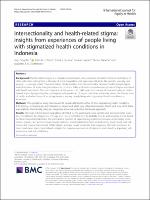Associations between the stringency of COVID-19 containment policies and health service disruptions in 10 countries
| Reddy, Tarylee
Kapoor, Neena R. Kubota, Shogo Doubova, Svetlana V Asai, Daisuke Mariam, Damen Haile Ayele, Wondimu Mebratie, Anagaw Derseh Thermidor, Roody Sapag, Jaime C. Bedregal, Paula Passi-Solar, Álvaro Gordon-Strachan, Georgiana Dulal, Mahesh Gadek, Dominic Dormenyo Mehata, Suresh Margozzini, Paula Leerapan, Borwornsom Rittiphairoj, Thanitsara Kaewkamjornchai, Phanuwich Nega, Adiam Awoonor-Williams, John Koku Kruk, Margaret E. Arsenault, Catherine |
|
| 2023-04-12 | |
|
Background: Disruptions in essential health services during the COVID-19 pandemic have been reported in several countries. Yet, patterns in health service disruption according to country responses remain unclear. In this paper, we investigate associations between the stringency of COVID-19 containment policies and disruptions in 31 health services in 10 low- middle- and high-income countries in 2020. Methods: Using routine health information systems and administrative data from 10 countries (Chile, Ethiopia, Ghana, Haiti, Lao People’s Democratic Republic, Mexico, Nepal, South Africa, South Korea, and Thailand) we estimated health service disruptions for the period of April to December 2020 by dividing monthly service provision at national levels by the average service provision in the 15 months pre-COVID (January 2019-March 2020). We used the Oxford COVID-19 Government Response Tracker (OxCGRT) index and multi-level linear regression analyses to assess associations between the stringency of restrictions and health service disruptions over nine months. We extended the analysis by examining associations between 11 individual containment or closure policies and health service disruptions. Models were adjusted for COVID caseload, health service category and country GDP and included robust standard errors. Findings: Chronic disease care was among the most affected services. Regression analyses revealed that a 10% increase in the mean stringency index was associated with a 3.3 percentage-point (95% CI -3.9, -2.7) reduction in relative service volumes. Among individual policies, curfews, and the presence of a state of emergency, had the largest coefficients and were associated with 14.1 (95% CI -19.6, 8.7) and 10.7 (95% CI -12.7, -8.7) percentage-point lower relative service volumes, respectively. In contrast, number of COVID-19 cases in 2020 was not associated with health service disruptions in any model. Conclusions: Although containment policies were crucial in reducing COVID-19 mortality in many contexts, it is important to consider the indirect effects of these restrictions. Strategies to improve the resilience of health systems should be designed to ensure that populations can continue accessing essential health care despite the presence of containment policies during future infectious disease outbreaks. |
|
| COVID‐19 restrictions
Health systems Health services Pandemic response Health system resilience Health care disruptions |
|
| Research paper | |
| Text | |
| application/pdf | |
| This work is licensed under a Creative Commons Attribution 4.0 International license (CC BY 4.0). | |
| Open access | |
| Copyright (c) 2023 The Authors. | |
| https://resources.equityinitiative.org/handle/ei/646 |
This item appears in the following Collection(s) |
|
|
Collections
|
Related items
Showing items related by title, author, creator and subject.
-
Human resources for health: task shifting to promote basic health service delivery among internally displaced people in ethnic health program service areas in eastern Burma/Myanmar
Low, Sharon; Tun, Kyaw Thura; Mhote, Naw Pue Pue; Htoo, Saw Nay; Maung, Cynthia; Kyaw, Saw Win; Oo, Saw Eh Kalu Shwe; Pocock, Nicola Suyin (2014-09-29)
Background: Burma/Myanmar was controlled by a military regime for over 50 years. Many basic social and protection services have been neglected, specifically in the ethnic areas. Development in these areas was led by the ethnic non-state actors to ensure care and the availability of health services for the communities living in the border ethnic-controlled areas. Political changes in Burma/Myanmar have been ongoing since the end of 2010. Given the ethnic diversity of Burma/Myanmar, many challenges in ensuring health service coverage among all ... -
Can mHealth and eHealth improve management of diabetes and hypertension in a hard-to-reach population? —lessons learned from a process evaluation of digital health to support a peer educator model in Cambodia using the RE-AIM framework
Steinman, Lesley; Pelt, Maurits van; Hen, Heang; Chhea, Chhorvann; Lan, Channe Suy; Te, Vannarath; LoGerfo, James; Fitzpatrick, Annette L. (2020-10-05)
Background: The burden of non-communicable diseases (NCDs) is increasing in low- and middle-income countries (LMICs) where NCDs cause 4:5 deaths, disproportionately affect poorer populations, and carry a large economic burden. Digital interventions can improve NCD management for these hard-to-reach populations with inadequate health systems and high cell-phone coverage; however, there is limited research on whether digital health is reaching this potential. We conducted a process evaluation to understand challenges and successes from a digital ... -
Intersectionality and health-related stigma: insights from experiences of people living with stigmatized health conditions in Indonesia
Rai, Sarju Sing; Peters, Ruth M. H.; Syurina, Elena V.; Irwanto, Irwanto; Naniche, Denise; Zweekhorst, Marjolein B. M. (International Journal for Equity in Health, 2020-12)
Abstract Background Health-related stigma is a complex phenomenon, the experience of which intersects with those of other adversities arising from a diversity of social inequalities and oppressive identities like gender, sexuality, and poverty – a concept called “intersectionality”. Understanding this intersectionality between health-related stigma and other forms of social marginalization can provide a fuller and more comprehensive picture of stigma associated with health conditions. The main objective ...



